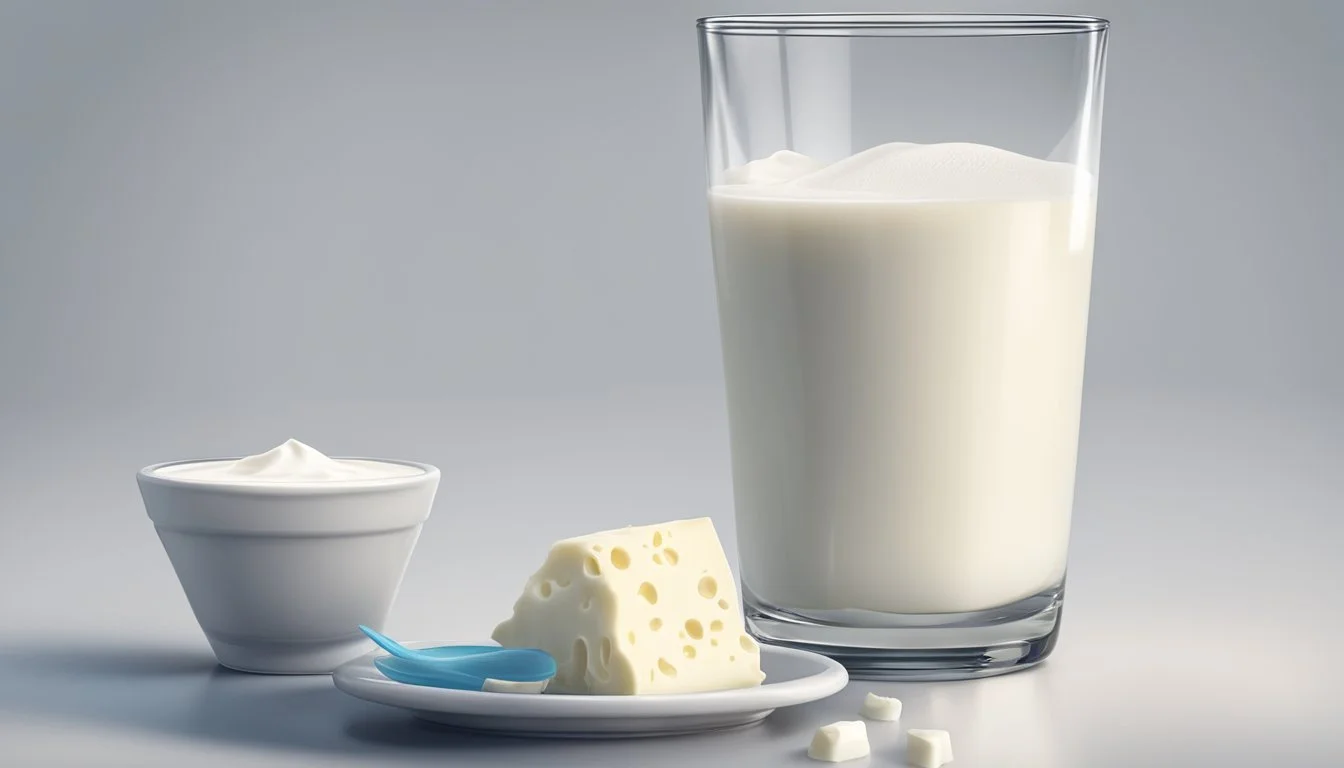What is Lactose Intolerance?
Understanding the Digestive Condition
Lactose intolerance is a common digestive disorder characterized by the body's inability to digest lactose, the main sugar found in milk and dairy products. This condition stems from a deficiency in lactase, the enzyme produced by the lining of the small intestine, which is necessary for the breakdown of lactose into glucose and galactose—simpler sugars that the body can absorb. When lactose is not adequately digested, it accumulates in the intestine, drawing in water and fermenting due to intestinal bacteria, leading to the symptoms associated with this condition.
Individuals with lactose intolerance typically experience gastrointestinal symptoms, which may include bloating, diarrhea, gas, and abdominal discomfort, following the consumption of lactose-containing foods. The severity of symptoms can vary greatly from person to person and depends on the amount of lactose ingested and the level of lactase deficiency.
Management of lactose intolerance involves dietary modifications, such as reducing or eliminating lactose-containing products or consuming lactose-free alternatives, and in some cases, taking lactase enzyme supplements. Through these measures, people with lactose intolerance can effectively mitigate symptoms and maintain a healthy, balanced diet.
Understanding Lactose Intolerance
Lactose intolerance is a condition characterized by the body's inability to digest lactose, the sugar found in milk and dairy products. This section outlines what lactose intolerance is, the enzyme vital for its digestion, and its different forms.
Definition and Overview
Lactose intolerance occurs when an individual's small intestine produces insufficient lactase, an enzyme necessary to break down lactose into simpler forms of sugars for absorption. Without adequate lactase, lactose remains undigested in the gut, leading to gastrointestinal symptoms such as bloating, gas, and diarrhea.
The Role of Lactase
Lactase is an enzyme located in the small intestine's lining. Its specific function is to cleave lactose molecules into glucose and galactose, which are easily absorbed into the bloodstream. When lactase is lacking or its activity is reduced, lactose intolerance manifests.
Variants of Lactose Intolerance
There are primarily three types of lactose intolerance:
Primary Lactose Intolerance: This common form develops over time as lactase production decreases after childhood, a normal process in some populations.
Secondary Lactose Intolerance: It emerges due to the small intestine's injury or illness affecting lactase production.
Congenital or Developmental Lactose Intolerance: Although rare, this condition occurs from birth due to genetic mutations (congenital) or develops shortly after birth (developmental).
Causes of Lactose Intolerance
Lactose intolerance stems from the body's inability to digest lactose, a sugar found in milk and dairy products, due to a deficiency of the lactase enzyme. Specific genetic factors, environmental influences, and secondary causes contribute to this deficiency.
Genetic Factors
Lactose intolerance can often be traced to genetic predispositions. Primary lactose intolerance is the most common type, where the production of lactase declines significantly following weaning, a process driven by a gene that reduces lactase activity in adulthood. This type of lactose intolerance is common among people of Asian, African, and Hispanic descent.
Environmental Influence
Environmental factors influencing lactose intolerance are less common but can include certain infections or diseases affecting the small intestine. An illness that damages the intestinal wall can temporarily reduce lactase production.
Secondary Causes
Secondary lactose intolerance occurs as a result of injury or surgery to the small intestine or from intestinal complications due to diseases like celiac disease. These conditions can reduce lactase production, which is necessary for the digestion of lactose. Illnesses like Crohn's disease can also contribute to secondary lactose intolerance.
Symptoms and Diagnosis
Understanding lactose intolerance begins with recognizing its symptoms and obtaining an accurate diagnosis primarily through specific tests. This section discuses the common signs that indicate lactose intolerance and the diagnostic tests used to confirm the condition.
Common Symptoms
Individuals with lactose intolerance often experience a range of digestive symptoms after consuming dairy products. Bloating, diarrhea, and nausea frequently occur, as the body struggles to digest lactose, a sugar found in milk. These symptoms typically arise within a few hours post-consumption. Pain in the abdomen and a stool consistency change may also manifest. Some individuals report additional symptoms related to the condition, such as vomiting and changes in breath.
Diagnostic Tests
To confirm lactose intolerance, healthcare providers may recommend specific diagnostic tests. The hydrogen breath test is common; it measures the amount of hydrogen in the breath after drinking a lactose-rich beverage, reflecting lactose malabsorption. Another option is a blood test that assesses the blood glucose level to see if it rises appropriately after lactose ingestion, indicating proper digestion. For children and infants, the stool acidity test can be used, as it checks for lactic acid in the stool, a byproduct of undigested lactose. These tests aim to accurately diagnose lactase deficiency, which underlies lactose intolerance.
Nutritional Considerations
For individuals with lactose intolerance, ensuring a balanced diet and adequate intake of essential nutrients is crucial, particularly when dairy products, a common source of calcium and vitamin D, are limited or excluded.
Dietary Management
The key to managing lactose intolerance is identifying and limiting foods that cause symptoms while maintaining nutritional balance. Dairy products such as milk, cheese, and yogurt are high in lactose, and those with lactose intolerance should avoid them or opt for lactose-free versions. One must pay close attention to calcium and vitamin D intake, as these nutrients are often less in non-dairy sources. Probiotics found in fermented foods like kefir can sometimes help in managing symptoms by improving gut health.
Individuals should carefully read food labels for hidden sources of lactose in processed foods and be mindful of the quantity consumed. Gradually introducing small amounts of dairy may help some people build tolerance over time.
Alternative Foods and Supplements
When dairy is not an option, one must seek alternative sources of essential nutrients typically found in milk products.
Calcium: Can be found in fortified foods and beverages, leafy greens, and fish with bones. It's essential for bone health.
Vitamin D: Necessary for calcium absorption, vitamin D is available through sun exposure, fortified foods, and supplements.
Supplements: Calcium and vitamin D supplements can be helpful, but it's best to consult a healthcare provider for personalized advice.
Here is a table that lists out alternative food sources:
Nutrient Alternative Food Sources Calcium Broccoli, oranges, almonds, tofu, fortified cereals Vitamin D Fortified orange juice, fortified soy milk, egg yolks Lactose-free Lactose-free milk and milk products, almond milk
In conclusion, those with lactose intolerance should focus on incorporating these alternatives and consider supplements if they are unable to meet their nutritional needs through diet alone.
Living with Lactose Intolerance
Living with lactose intolerance requires understanding which foods to avoid and making daily life adaptations. It is important to know how to read food labels to maintain a balanced diet while managing symptoms.
Daily Life and Adaptations
Individuals with lactose intolerance often make adjustments in their daily diet to avoid discomfort. Dairy products such as milk, cheese, cream, butter, ice cream, and yogurt typically contain lactose, which can trigger symptoms. They can opt for lactose-free versions or alternatives made from almond, soy, rice, or coconut. Hard cheeses like parmesan have lower lactose content and may be tolerated in small quantities.
Those with lactose intolerance may also benefit from incorporating lactase enzyme supplements before consuming dairy, as these can aid in lactose digestion. They can also focus on other calcium-rich foods or beverages fortified with calcium and vitamin D to support bone health.
Incorporating probiotics into one's diet through supplements or fermented foods can improve digestive health. Maintaining a balance between avoidance of lactose and nutritional sufficiency is critical for overall health and requires thoughtful planning.
Understanding Food Labels
Reading food labels is essential for people with lactose intolerance to identify potential sources of lactose in their diet. Here’s what to look for:
Ingredients: Avoid products that list any of the following terms as these indicate the presence of lactose: milk, lactose, whey, curds, milk by-products, dry milk solids, and nonfat dry milk powder.
"Lactose-Free" labels: Items labeled as lactose-free have been processed to remove lactose and are generally safe for consumption by those with intolerance.
Nutrition Facts: Products may contain a section indicating the sugar content, including lactose, in grams.
Below is an example of how to interpret food labels:
Term on Label Meaning for Lactose Intolerance Milk or Milk Solids Contains lactose; likely to cause symptoms. Lactose-Free Safe to consume; lactose has been removed or is not present. Whey or Whey Products Usually contains lactose and should be evaluated based on individual tolerance. Cultured Milk Products (e.g. Yogurt) May be more tolerable due to the fermentation process breaking down lactose.
Understanding these labels empowers individuals to make informed decisions and minimizes the risk of mistakenly consuming lactose-containing products.
Societal and Demographic Factors
Lactose intolerance prevalence varies widely across different populations and age groups. These variances are often shaped by genetic adaptations and societal dietary habits.
Ethnic and Regional Variations
Lactose intolerance is significantly influenced by ethnic and geographic factors. For example, it is more common in people of African or Asian descent, where up to 90% of the population may be lactose intolerant. In contrast, a lower prevalence is seen among individuals of Northern European descent with rates as low as 5%. This geographical pattern is deeply rooted in the historical reliance on dairy in different cultures, where some have evolved a continued enzyme activity (lactase persistence) into adulthood.
African Populations: High rates of intolerance, with variability among different ethnic groups.
Northern Europe: Lower rates, attributed to a long history of dairy consumption and genetic adaptations.
Lactose Tolerance and Age
The ability to digest lactose is nearly universal among infants; it is, after all, a necessary adaptation for the digestion of mother's milk. However, as children grow, lactase production can decline significantly, leading to lactose intolerance in adulthood for many. Premature babies may exhibit lactose intolerance due to an underdeveloped lactase-producing system. The decline in lactase is also a natural developmental process that varies in onset and degree between individuals and populations, often based on genetics and dietary needs.
Infants: Typically lactose tolerant due to the need to digest breast milk.
Developmental Changes: As children grow, lactase production often decreases, which can lead to intolerance.
Research and Developments
In recent years, significant progress has been made in both the understanding and management of lactose intolerance. Research has shed light on the genetic basis of the condition, while treatment options have expanded beyond simple dietary alterations.
Recent Scientific Studies
Recent research has focused on the genetic and pathophysiological mechanisms underlying lactose intolerance. Studies have identified several genetic variants associated with lactase non-persistence, which is the reduction in lactase enzyme activity post-weaning. The National Institute of Diabetes and Digestive and Kidney Diseases (NIDDK) has supported work exploring the prevalence of lactose intolerance and its impact on nutrition and bone health. Innovative methodologies, like the use of prebiotics, are being investigated for their potential to ameliorate symptoms by altering gut flora to better digest lactose.
Advancements in Treatment
The treatment landscape for lactose intolerance is evolving. Traditional methods, such as dietary lactose restriction or lactase enzyme supplements, are being supplemented by newer strategies. Researchers have been exploring enzyme replacement therapy and genetic editing techniques with the aim of delivering a more permanent solution to lactase enzyme deficiency. Additionally, new forms of lactase enzyme supplements have been developed that are more effective in varying pH conditions of the stomach, improving symptom management. These advancements offer hope for those affected to manage their condition with greater ease and effectiveness.
Prevention and Management
Understanding lactose intolerance involves recognizing both the potential risk factors and adopting strategies for long-term management. This knowledge allows individuals to make informed decisions to reduce discomfort and maintain a healthy digestive system.
Risk Factors and Prevention Strategies
Risk Factors:
Primary lactose intolerance: Most commonly related to aging, as the production of lactase decreases over time.
Secondary lactose intolerance: Can occur due to injury to the small intestine from surgery, illness, or treatment like chemotherapy.
Ethnicity: More prevalent in people of Asian, African, Native American, or Hispanic descent due to genetic predispositions.
Premature birth: May lead to reduced lactase levels since lactase levels increase late in the third trimester.
Prevention Strategies: Since lactose intolerance is often due to factors outside of an individual's control, such as genetics, complete prevention may not be possible. However, identifying and mitigating risk factors where possible can be beneficial.
Early Detection: Be aware of symptoms and consult a healthcare provider for testing if lactose intolerance is suspected.
Dietary Adjustments: Introduce lactose-free or low-lactose products and consider dairy alternatives.
Monitoring: Certain probiotics may help the colon's bacteria digest lactose better, potentially reducing symptoms.
Long-Term Management
Managing lactose intolerance primarily involves dietary choices and lifestyle adjustments to minimize symptoms and maintain a healthy balance within the digestive tract.
Dietary Management:
Limit or avoid consumption of milk and dairy products.
Read food labels carefully, as lactose is often an additive in processed foods.
Consider the use of lactase enzyme supplements before consuming lactose-containing foods.
Digestive Health:
Consuming small amounts of lactose may help some individuals gradually adapt to the sugar, lessening symptoms over time.
Consistently support the immune system and digestive health with a balanced diet, including fibers that nurture beneficial colon bacteria.
For secondary lactose intolerance, addressing the underlying cause may improve lactase production in the small intestine.
Effective management involves personalized strategies, respecting one's unique immune system and digestive tract for optimal health. It is essential always to consult healthcare professionals before implementing any significant dietary changes.
Related Health Issues
Lactose intolerance can be associated with various other health conditions and can influence an individual's overall well-being. This section explores its associations with other digestive disorders and the broader impact it may have on general health.
Associations with Other Digestive Disorders
Lactose intolerance can coexist with other digestive disorders. These disorders may exacerbate lactose intolerance symptoms or may themselves be aggravated by the presence of lactose intolerance. For example, individuals with irritable bowel syndrome (IBS) often report increased sensitivity to lactose. In addition, patients who have experienced gastrointestinal infections or inflammatory bowel diseases like Crohn’s disease may develop what is known as secondary lactose intolerance. This form of lactose intolerance arises when the small intestine's ability to produce lactase is diminished due to an infection or inflammation.
Chemotherapy treatments for cancer can affect the lining of the gastrointestinal tract, potentially leading to secondary lactose intolerance.
Diagnosis of lactose intolerance in patients with coexisting digestive disorders can be challenging, as symptoms may overlap. A healthcare professional must carefully consider the patient’s full medical history and symptoms to ensure accurate diagnosis.
Impact on General Health
The symptoms of lactose intolerance, such as diarrhea, gas, and bloating, can affect the colon and overall digestive symptoms, impacting a person’s general health. Chronic digestive discomfort can lead to:
Decreased nutrient absorption
Weight loss
Fatigue
These issues can compound over time, affecting the immune system and increasing susceptibility to further health complications. It is important for those with lactose intolerance to manage their lactase deficiency to maintain a healthy and balanced digestive system and support their overall health.
Management strategies may include dietary adjustments, enzyme supplementation, or the consumption of lactose-free products to mitigate symptoms and maintain nutritional balance.
Practical Tips and Resources
Managing lactose intolerance effectively requires a strategic approach to diet and education on the condition. This includes preparing lactose-reduced meals and accessing educational resources to understand the intolerance better.
Preparing Lactose-Reduced Meals
People with lactose intolerance should focus on creating meals that either eliminate lactose or significantly reduce its presence. This often involves substituting traditional dairy products with lactose-free alternatives which are readily available in grocery stores. It is important to:
Read labels carefully: Processed foods, salad dressings, sauces, cereals, and bread often contain lactose. One should look for terms like "lactose" or "milk solids" on ingredient lists.
Consider natural alternatives: Choose dairy substitutes made from almond, soy, rice, or oat which are naturally lactose-free. Coconut milk is also a flavorful option for cooking and baking.
Introduce lactose-digesting aids: Over-the-counter products containing the enzyme lactase can help in digesting lactose when consumed with dairy products.
Recipe adaptations:
Incorporate lactose-free milk or milk products in traditional recipes.
Use broths, stocks, or lactose-free creams when making sauces and soups.
Balanced nutrition:
Ensure adequate calcium and vitamin D intake, which may be lower in a lactose-reduced diet. Foods like leafy greens, fortified orange juice, and fish can help maintain these essential nutrients.
Educational Resources
Understanding lactose intolerance can empower individuals to manage their symptoms better and maintain a healthy diet. Educational resources can provide insight into the condition, including its genetic components and how it affects the body's ability to process lactose:
The National Institute of Diabetes and Digestive and Kidney Diseases (NIDDK) offers comprehensive guides and information about lactose intolerance.
Healthcare providers: Dietitians and nutritionists can offer tailored advice and meal planning specifically designed for lactose intolerance.
Support groups and online communities: Connect with others who have lactose intolerance to share experiences, tips, and lactose-free recipes.
Learning the genetic basis for lactose intolerance may help some people understand their body's response to dairy products. Additionally, familiarizing oneself with how probiotics may influence gut health and lactose tolerance is beneficial.
One should also be aware that lactose intolerance is different from a food allergy; it is a reduced ability to digest lactose due to lower levels of lactase enzyme and does not involve the immune system.





